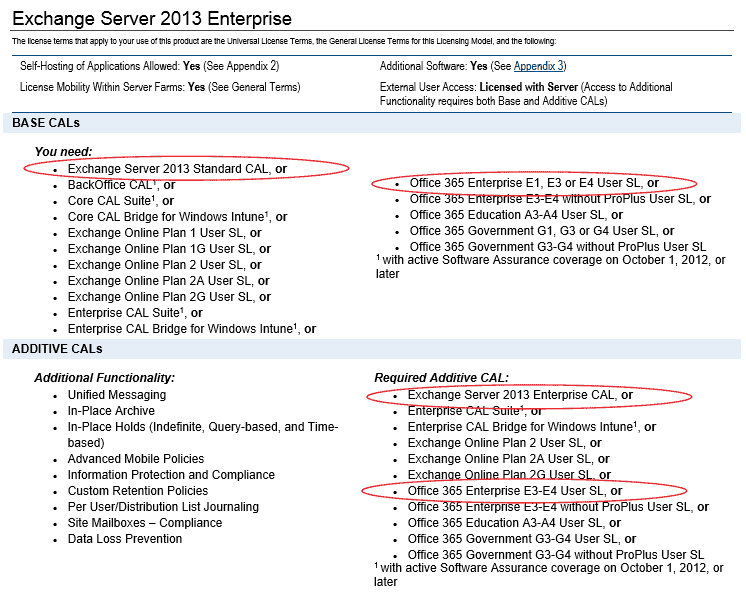
 So, let’s say you moved your organization to Office 365.
So, let’s say you moved your organization to Office 365.
You’re tired of shelling out a ton of money every three years to buy the next version of Office. (Okay, more realistically every six years as you leap-frogged over a version.) So, you decide to switch to monthly subscriptions instead. Out with the old and in with the new!
However, you’re not quite ready to give up your Exchange Server. And you’re even less ready to give up that nice new Lync server you invested in last year, or that SharePoint server that has been serving you faithfully for the last five years. So you’re really not interested in using the online versions of Exchange, Lync, and SharePoint that is included in many of the Office 365 bundles. You probably think to yourself, “Someday we might, but not now.”
But does that mean you now need to keep paying for monthly Office 365 subscriptions and keep buying CALs for all your users whenever you do an upgrade or hire more employees?
With the advent of Office 365, things are shifting in the Microsoft world. In many ways, Microsoft is moving away from on-premise solutions (where you install their software on hardware you own) and is moving toward cloud solutions (where Microsoft installs their software on their own hardware and lets you access it remotely).
Fortunately, they seem to bending over backwards to help bring their clients along the same path. For example, did you know that Microsoft is allowing certain Office 365 users to access on-premise instances of Exchange, Lync, and SharePoint without a User CAL?
This was first brought to my attention by one of our Mirazon engineers who was confused about what CALs and server licenses came with the E3 bundle of Office 365. I decided to set him straight so I firmly told him, “There are no on-prem server or CAL licenses that come with Office 365 E3” … and to some degree I was correct.
But what I didn’t know (and what this engineer brought to my attention) was that Microsoft includes certain on-premise use rights with some of the Office 365 bundles. I first read about it in this blog post on the Microsoft Volume Licensing Blog. The key statement in that post is this:
While the applicable application server CALs are not included in the Office 365 User subscription License, a CAL equivalency use right is included to access the on premises application server.
In other words, Office 365 doesn’t give you a CAL, but some of the Office 365 plans give you the same rights that you get from a CAL.
But I didn’t stop there. The volume licensing blog team at Microsoft was a pretty high authority, but also I wanted more than just a blog post as my point of reference when recommending a solution to our clients. So, I went straight for the highest authority: the Microsoft Product Use Rights (PUR) document. The “PUR” may sound cute and cuddly, but it is dry reading. However, it is the final authority when you have a question about Microsoft licensing. And sure enough, there it was in black and white….
In the screenshot below, you can see the section in the PUR that discusses the proper way to license Exchange Server. (You can click on the image for a higher resolution.) Notice that for a base CAL, you can either use an “Exchange Server 2013 Standard CAL” or you can use an “Office 365 Enterprise E1, E3 or E4 User SL [Subscription License].” And for the Additive CAL, you can either use an “Exchange Server 2013 Enterprise CAL” or you can use an “Office 365 Enterprise E3-E4 User SL.”
So although it is correct to say that an Office 365 subscription does not provide you with an actual CAL, it is also correct to say that certain Office 365 subscriptions do provide you with the same rights as a CAL.
This is an important point for a company that is moving their users to Office 365. For example, if you hire new employees and you sign those employees up for an Office 365 bundle, then you don’t necessarily need to purchase Exchange CALs for them (or Lync CALs or SharePoint CALs). Just make sure you purchase one of the Office 365 bundles that includes the on-premise access rights. Depending on your size and situation, this could save you a significant amount of money.
However, please note that Office 365 by itself does not give you the right to install the server software and run it on premise. It only provides the user with the right to access the server software, so you will need to bring your own Exchange/Lync/SharePoint Server license to the table. Also, it does not give you the right to access the Windows Server or the SQL Server that may be sitting in the background providing functionality to that Exchange, Lync, or SharePoint server (see my previous post about needing a SQL CAL for every SharePoint CAL you use). You will still need the appropriate Window Server CALs and SQL Server CALs to be properly licensed. However, certain Office 365 subscriptions can get you part of the way there by providing access rights for Exchange, Lync, and SharePoint.
For full details on which Office 365 plans include these on-premise access rights, check out the latest PUR document.
Or you can check out the Microsoft blog post for a list of what the equivalents are (or at least what they were in October 2013).
